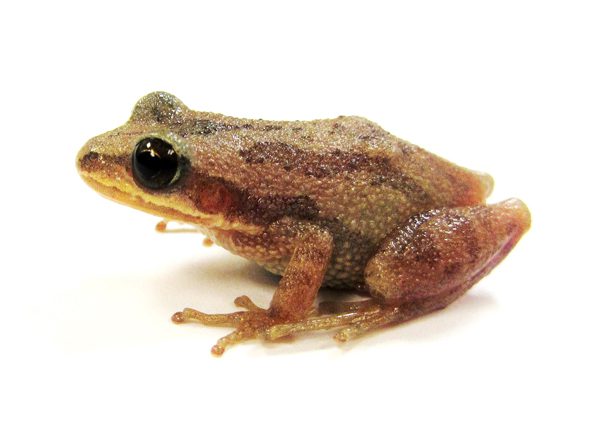A chorus of frogs

This winter’s pattern of hot and cold weather has made it challenging for people and animals to adapt. The recent wet weather and warmer temperatures must have been a cue for the upland chorus frogs that their breeding season has arrived. I heard them calling loudly from the small stream at my apartment complex. Their vocalization is pretty distinctive. I’ve heard it described as being a similar sound to running your fingernails over a comb – sort of a sharp vibrato in a nasally tenor’s pitch, with an ascending crescendo that gets louder as it goes.
To me it sounds like springtime when I was growing up. We’d sit on the porch in a storm and listen to the chorus frogs’ repetitive refrain as many of them joined together in unison, all saying “kreee-eeek,” as raindrops hit the tin roof like tiny drumbeats accompanying their melodic song. And on a calm night after rains, the monotony of that natural spring ballad lulled me to sleep more than once on that front porch swing, slowly swaying in the cool breeze.
Many of us raised in the Piedmont can easily pick out the sound of an upland chorus frog, and probably could identify most of our state’s “calling amphibians” by their calls, even if not by their scientific name. If you already know the calls of our state’s frogs and toads, or if you’re interested in learning (and you can brush up on them all at www.herpsofnc.org), I encourage you to consider getting involved with a program called CASP – the North Carolina Calling Amphibian Survey Program.
CASP is a volunteer-based monitoring program administered by the North Carolina Wildlife Resources Commission (NCWRC). North Carolina CASP coordinates with the North American Amphibian Monitoring Program (NAAMP) that hosts an online database administered by the United States Geological Survey (USGS). I’ve signed up to do a route this year for the first time.
Basically, a volunteer is given a route to drive along a road, and each route has 10 listening stops at least a half-mile apart at amphibian breeding areas, such as wetlands or ponds or streams. The CASP program in N.C. consists of four non-random routes and 137 routes randomly placed throughout the state. Volunteers drive these routes during an identified sampling window provided by NCWRC. They stop to listen and record the calls of the breeding frogs and toads they hear, also writing down the species they note.
The information gathered by volunteers is compiled with data from other states and reveals trends and information about our calling amphibians. This is important because these species as a group are largely in decline, as they face multiple stressors. They live in sensitive habitats that are often negatively affected by pollution from runoff, invasive species, and changing hydrology and climate.
These species play critical roles in the ecosystem, and understanding their habitat needs and distribution is essential to evaluating the threats they face and mitigate or avoid those threats. It is also important to ensure that the wide diversity of species we have are around for future generations. It would be a loss to our cultural and natural identity if the sounds of the upland chorus frogs fell silent. Future generations deserve the same opportunities we have had to know the sounds of their Southern heritage, and we must all do our part to help preserve the species who call this area home.
To learn more about CASP or to volunteer, please visit http://www.ncparc.org/casp/casp.htm or contact Jeff Hall at jeff.hall@ncwildlife.org.